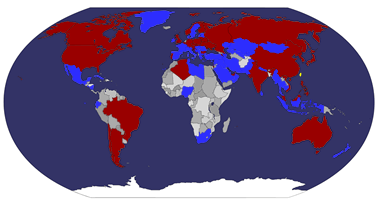
The Mallard (Anas platyrhynchos), probably the best-known and most recognizable of all ducks, is a dabbling duck which breeds throughout the temperate and sub-tropical areas of North America, Europe, Asia, New Zealand (where it is currently the most common duck species), and Australia. It is strongly migratory in the northern parts of its breeding range, and winters farther south. For example, in North America it winters south to Mexico, but also regularly strays into Central America and the Caribbean between September and May.
The Green-winged Teal (GWT, Anas carolinensis) is a common and widespread duck which breeds in the northern areas of North America except on the Aleutian Islands. It was considered conspecific with the Common Teal for some time, and the issue is still being reviewed by the American Ornithologists' Union [1]; based on this the IUCN and BirdLife International (BirdLife International, 2004) do not accept it as a separate species at present. However, nearly all other authorities consider it distinct nowadays, based on behavioral (Laurie-Ahlberg & McKinney 1979), morphological (Livezey, 1991), and molecular (Johnson & Sorenson 1999) evidence (discussed by Sangster et al., 2002).
The Tufted Duck, Aythya fuligula, is a medium-sized diving duck with a population of close to one million birds.
The adult male is all black except for white flanks and a blue-grey bill. It has an obvious head tuft that gives the species its name. The adult female is brown with paler flanks, and is more easily confused with other diving ducks. In particular, some have white around the bill base which resembles the scaup species, although the white is never as extensive as in those ducks.
The only duck which is at all similar is the drake North American Ring-necked Duck, which however has a different head shape, no tuft and greyish flanks.
The Tufted Duck is one of the species to which the Agreement on the Conservation of African-Eurasian Migratory Waterbirds (AEWA) applies.
The Cotton Pygmy Goose or the Cotton Teal,[2] Nettapus coromandelianus is a small perching duck which breeds in India, Pakistan, southeast Asia and south to northern Australia. It is locally known as Girri, Girria, Girja (Hindi); Gurgura (Etawah); Bali hans (Bengal); Bhullia hans (Bangladesh); Dandana (Orissa); Ade, Atla (Ratnagiri); Naher, Keeke, Chuwa (Nowgong, Assam); Baher, Kararhi (Sind, Pakistan).
Le Canard colvert (Anas platyrhynchos)[1] est un oiseau de l'ordre des ansériformes, de la famille des anatidés et de la sous-famille des anatinés. C'est certainement le plus connu et reconnaissable de tous les canards, du fait de l'existence de races de canards domestiques issues de cette espèce.
La sarcelle à ailes vertes (Anas carolinensis ou Anas crecca caroliensis) est un canard de la famille des Anatidae largement répandu dans toute l'Amérique du Nord en dehors des îles Aléoutiennes. Cette espèce est, selon les auteurs, une espèce proche ou une sous-espèce de la sarcelle d'hiver.
Le fuligule morillon (Aythya fuligula) est un canard plongeur de la famille des Anatidés.
C'est un canard de 40 à 47 cm de long avec une envergure de 67 à 72 cm, pesant entre 550 et 900 g, donc un peu plus petit qu'un fuligule milouin par exemple.
Le mâle a un plumage noir brillant et des flancs blancs, ainsi qu'une fine huppe noire de 5 cm et retombante. La femelle est uniformément brune avec une huppe plus courte. En vol, on les reconnaît grâce à une barre alaire blanche.
L'Anserelle de Coromandel (Nettapus coromandelianus) est un oiseau palmipède appartenant à la famille des anatidae.









.jpg)























 taiwan
taiwan  cover or postcard
cover or postcard  FDC
FDC 






























































































No comments:
Post a Comment